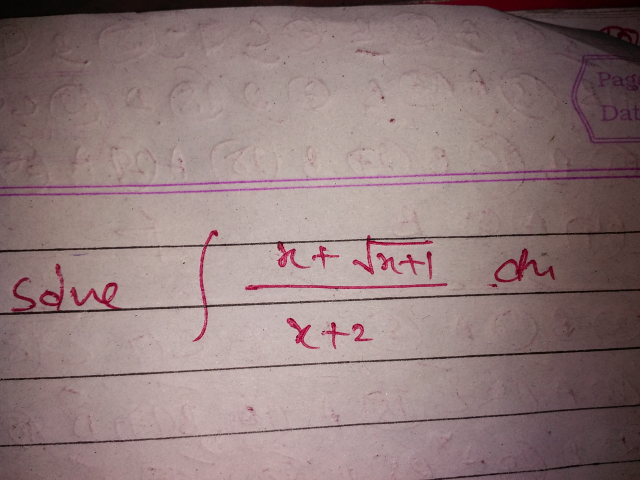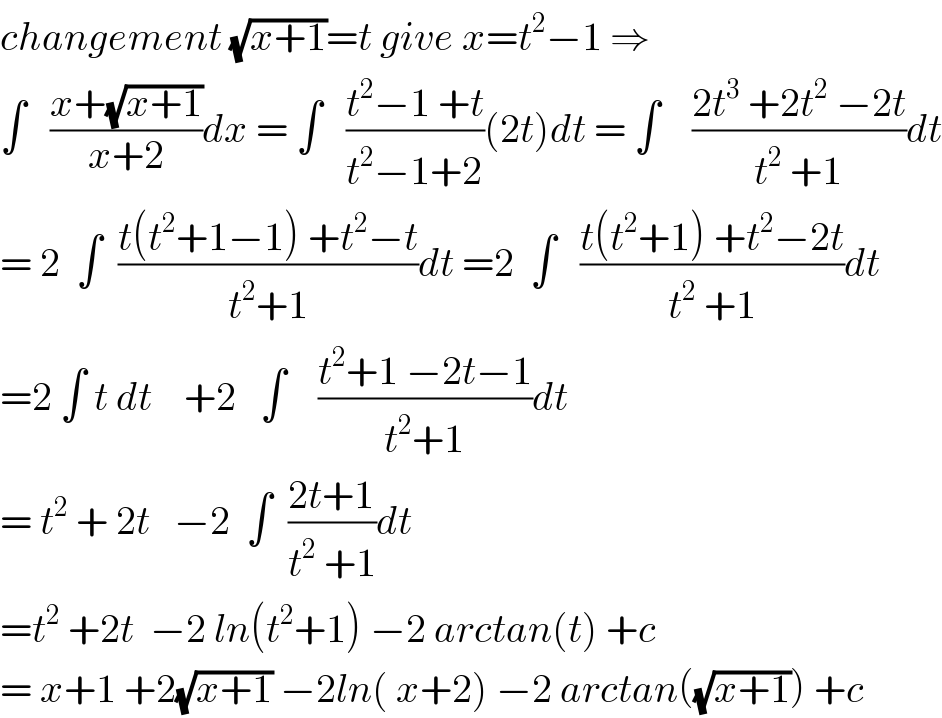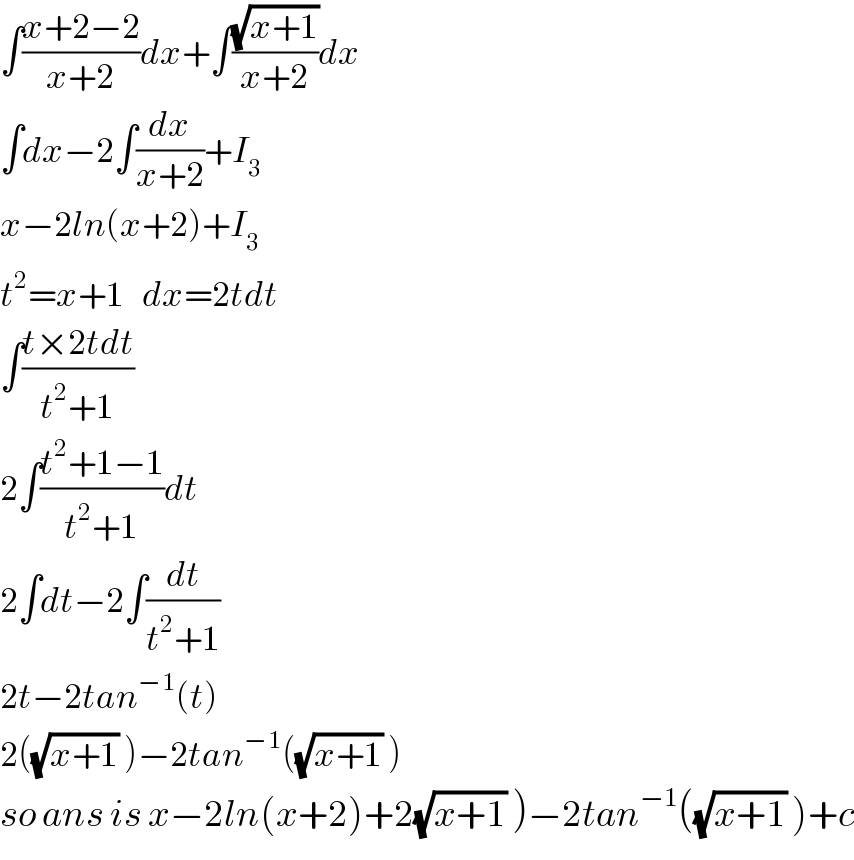Question Number 42580 by Raj Singh last updated on 28/Aug/18

Commented by maxmathsup by imad last updated on 28/Aug/18

$${changement}\:\sqrt{{x}+\mathrm{1}}={t}\:{give}\:{x}={t}^{\mathrm{2}} −\mathrm{1}\:\Rightarrow \\ $$$$\int\:\:\:\frac{{x}+\sqrt{{x}+\mathrm{1}}}{{x}+\mathrm{2}}{dx}\:=\:\int\:\:\:\frac{{t}^{\mathrm{2}} −\mathrm{1}\:+{t}}{{t}^{\mathrm{2}} −\mathrm{1}+\mathrm{2}}\left(\mathrm{2}{t}\right){dt}\:=\:\int\:\:\:\:\frac{\mathrm{2}{t}^{\mathrm{3}} \:+\mathrm{2}{t}^{\mathrm{2}} \:−\mathrm{2}{t}}{{t}^{\mathrm{2}} \:+\mathrm{1}}{dt} \\ $$$$=\:\mathrm{2}\:\:\int\:\:\frac{{t}\left({t}^{\mathrm{2}} +\mathrm{1}−\mathrm{1}\right)\:+{t}^{\mathrm{2}} −{t}}{{t}^{\mathrm{2}} +\mathrm{1}}{dt}\:=\mathrm{2}\:\:\int\:\:\:\frac{{t}\left({t}^{\mathrm{2}} +\mathrm{1}\right)\:+{t}^{\mathrm{2}} −\mathrm{2}{t}}{{t}^{\mathrm{2}} \:+\mathrm{1}}{dt} \\ $$$$=\mathrm{2}\:\int\:{t}\:{dt}\:\:\:\:+\mathrm{2}\:\:\:\int\:\:\:\:\frac{{t}^{\mathrm{2}} +\mathrm{1}\:−\mathrm{2}{t}−\mathrm{1}}{{t}^{\mathrm{2}} +\mathrm{1}}{dt} \\ $$$$=\:{t}^{\mathrm{2}} \:+\:\mathrm{2}{t}\:\:\:−\mathrm{2}\:\:\int\:\:\frac{\mathrm{2}{t}+\mathrm{1}}{{t}^{\mathrm{2}} \:+\mathrm{1}}{dt} \\ $$$$={t}^{\mathrm{2}} \:+\mathrm{2}{t}\:\:−\mathrm{2}\:{ln}\left({t}^{\mathrm{2}} +\mathrm{1}\right)\:−\mathrm{2}\:{arctan}\left({t}\right)\:+{c} \\ $$$$=\:{x}+\mathrm{1}\:+\mathrm{2}\sqrt{{x}+\mathrm{1}}\:−\mathrm{2}{ln}\left(\:{x}+\mathrm{2}\right)\:−\mathrm{2}\:{arctan}\left(\sqrt{{x}+\mathrm{1}}\right)\:+{c} \\ $$
Answered by tanmay.chaudhury50@gmail.com last updated on 28/Aug/18

$$\int\frac{{x}+\mathrm{2}−\mathrm{2}}{{x}+\mathrm{2}}{dx}+\int\frac{\sqrt{{x}+\mathrm{1}}}{{x}+\mathrm{2}}{dx} \\ $$$$\int{dx}−\mathrm{2}\int\frac{{dx}}{{x}+\mathrm{2}}+{I}_{\mathrm{3}} \\ $$$${x}−\mathrm{2}{ln}\left({x}+\mathrm{2}\right)+{I}_{\mathrm{3}} \\ $$$${t}^{\mathrm{2}} ={x}+\mathrm{1}\:\:\:{dx}=\mathrm{2}{tdt} \\ $$$$\int\frac{{t}×\mathrm{2}{tdt}}{{t}^{\mathrm{2}} +\mathrm{1}} \\ $$$$\mathrm{2}\int\frac{{t}^{\mathrm{2}} +\mathrm{1}−\mathrm{1}}{{t}^{\mathrm{2}} +\mathrm{1}}{dt} \\ $$$$\mathrm{2}\int{dt}−\mathrm{2}\int\frac{{dt}}{{t}^{\mathrm{2}} +\mathrm{1}} \\ $$$$\mathrm{2}{t}−\mathrm{2}{tan}^{−\mathrm{1}} \left({t}\right) \\ $$$$\mathrm{2}\left(\sqrt{{x}+\mathrm{1}}\:\right)−\mathrm{2}{tan}^{−\mathrm{1}} \left(\sqrt{{x}+\mathrm{1}}\:\right) \\ $$$$\left.{so}\:{ans}\:{is}\:{x}−\mathrm{2}{ln}\left({x}+\mathrm{2}\right)+\mathrm{2}\sqrt{{x}+\mathrm{1}}\:\right)−\mathrm{2}{tan}^{−\mathrm{1}} \left(\sqrt{{x}+\mathrm{1}}\:\right)+{c} \\ $$
